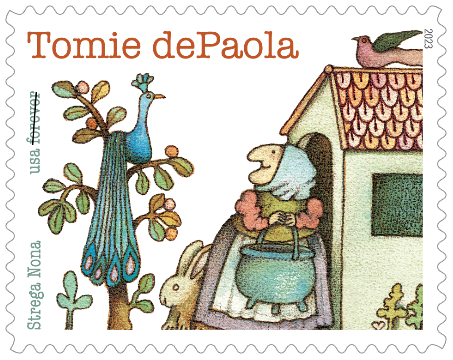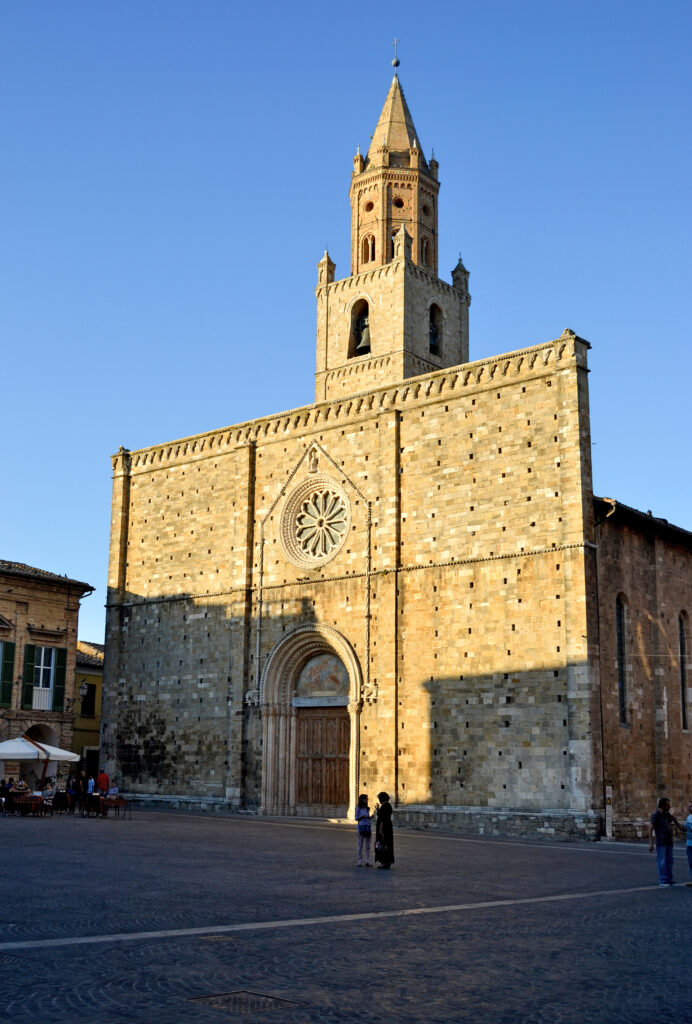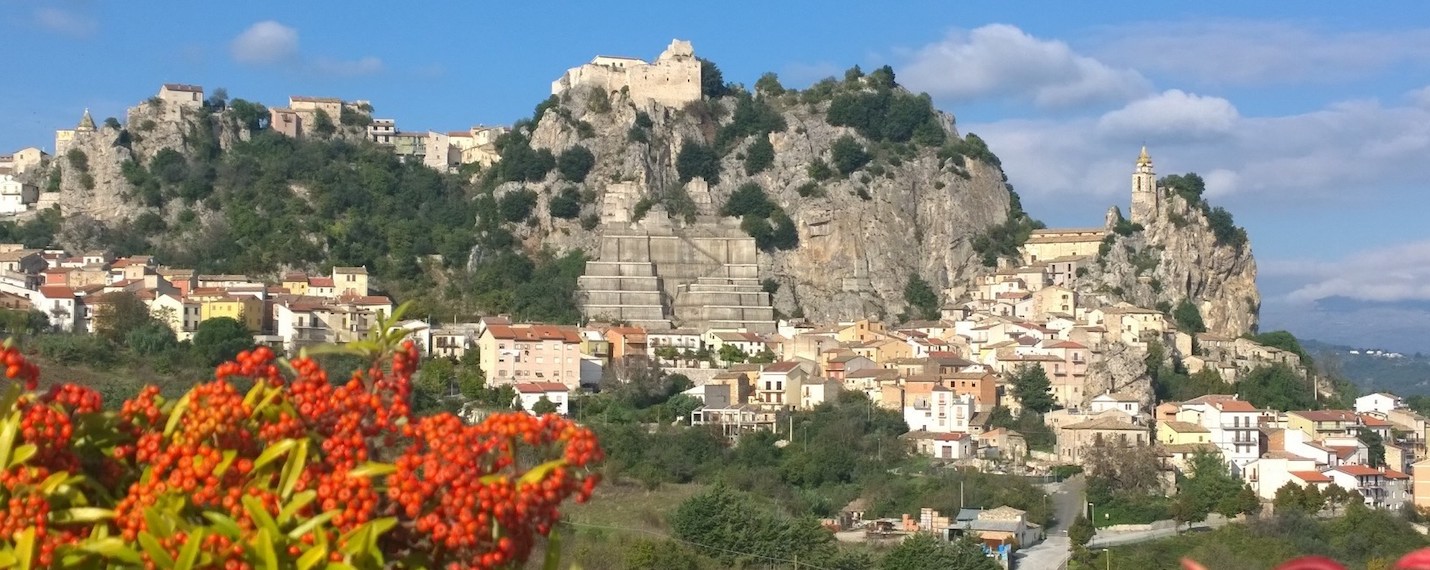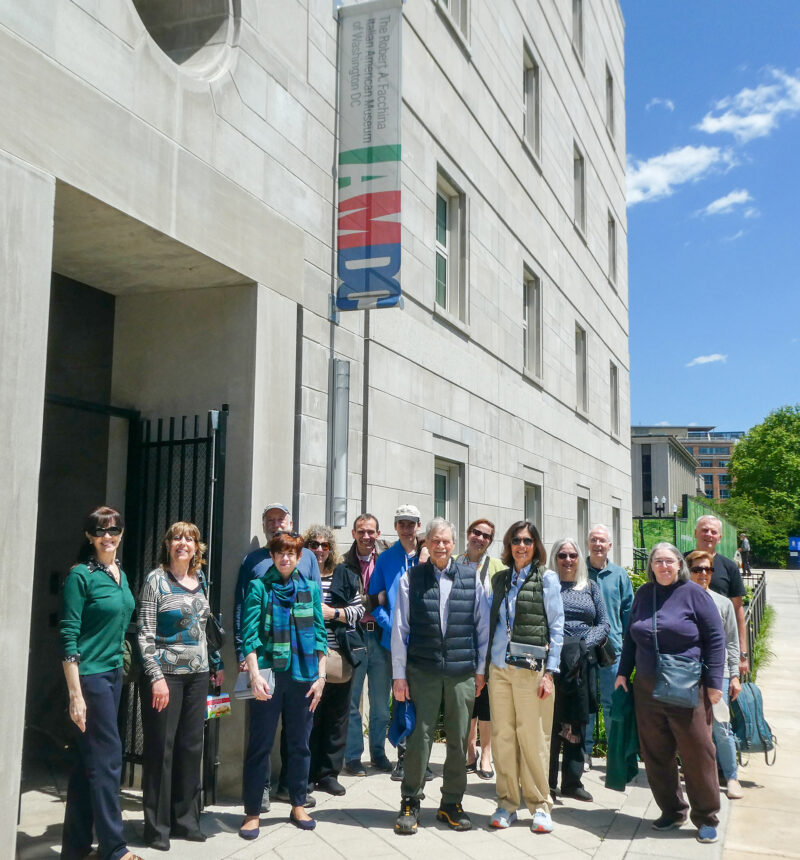-
U.S. Postal Service Issues Stamp for Tomie dePaola

Credit: USPS By Joseph “Sonny” Scafetta, Jr.

Tomie dePaola
Credit: WikipediaThe U.S. Postal Service unveiled a “Forever” postage stamp to honor Tomie dePaola on May 5, 2023, in a first-day-of-issue ceremony inside the Currier Museum of Art in Manchester, N. H. The stamp went on sale nationwide on Saturday, May 6, 2023.
The stamp shows a detail from the cover of Strega Nona (Witch Grandmother), a Caldecott Honor Book published in 1975. Tomie dePaola was a prolific children’s book author and illustrator whose body of work includes Italian folk tales and legends, informative books, religious and holiday stories, and autobiographical accounts.
Thomas Anthony dePaola was born in Meriden, Connecticut, on September 15, 1934. He was the son of Joseph dePaola and Florence May Downey dePaola. His paternal grandparents had emigrated from the region of Calabria. After earning a Bachelor of Fine Arts from the Pratt Institute in Brooklyn in 1956 and a Master of Fine Arts from the California College of Arts in 1969, he started his writing and illustrating career, working on more than 270 books, and selling more than 25 million copies worldwide. Most were translated into over 20 languages. Over the course of his 50-year career, he won numerous awards, most notably the prestigious Laura Ingalls Wilder Medal in 2011.
On March 23, 2020, he was injured in a fall inside his barn studio, underwent surgery, but died from complications on March 30, 2020, in a hospital in Lebanon, New Hampshire. He was 85.
July/August 2023
-
Atri

By Nancy DeSanti
Province of Teramo, Region of Abruzzo
The beautiful small town of Atri is located in the province of Teramo. It has approximately 12,580 inhabitants, known as Atriani. Located six miles from the Adriatic Sea, it may be one of the oldest cities in Abruzzo. Atri is the setting of the poem “The Bell of Atri“ by American poet Henry Wadsworth Longfellow. Its name is thought to come from the name of the Emperor Hadrian, whose family came from the town.

Atri Cathedral
Credit: WikipediaOn the top of a 3-pointed hill near the Adriatic with the majestic Gran Sasso in the background, and in a key position above the Val Vomano, the town was famous and powerful in antiquity and is today considered one of the most important historical, cultural, and artistic centers in Abruzzo. The surrounding landscape is also impressive for the canyon-like coves and the partly unexplored caves.
Called Hatria in Roman times, the town was a Roman colony from which, many historians believe, the name of the Adriatic Sea is also derived. In the 6th century B.C., the town was one of the four major Greek harbors on the Adriatic. In 290, it was conquered by Rome. After the fall of the Roman Empire, the territory came under the power of the Lombards in the 6th century and was annexed to the Duchy of Spoleto. Then the Normans came, and in 1393, Atri was bought by the House of Acquaviva, under whose power a period of great splendor for the city began. At the end of the 18th century, it was given by the Acquaviva to the Kingdom of Naples.
In the Villa Comunale dei Cappuccini, there are caves, probably once used as stables by the Capuchin friars. It is likely that they were also used to escape during pirate raids. Close to the lookout over the sea and all of the valleys of the Terre del Cerrano (from Roseto degli Abruzzi up to Silvi Marina), there is a fountain, considered the emblem of the Villa Comunale.
Another symbol of the villa, renovated in the 1930s in an Italian garden, is the formaggione (the big cheese), a cylindrically shaped hedge, comprising conifers, with four entrances (located at the cardinal points). It represents the Garden of Secrets, a recurring element in many gardens of the castles and the noble villas of Italy, especially between the late 18th and early 19th century.
Atri is also the home of Sartoria dei Duchi, a bespoke menswear atelier where the founder, Piero Pavone, keeps alive the craftsmanship of Italian men’s tailoring, specifically the craftsmanship of the Abruzzo region.
While Atri may be a small village, what Pavone said what he offers at Sartoria dei Duchi is world-class and has garnered a global consumer demand which has driven the expansion of the brand into markets such as Dubai and Singapore, with upcoming locations in London and Saudi Arabia. He said consumers fall in love with the history-infused proposition of the brand, but continue to come back for its heritage craftsmanship made with the finest textiles available from houses such as Loro Piana and Piacenza.
What to See
- Cattedrale di Santa Maria Assunta from the late 12th century
- Palazzo Ducale Acquaviva, a fortress built on the highest point of the town, now the seat of the municipality;
- Medieval walls, with Porta Macelli and Porta San Domenico
- Museo Capitolare
- Church of San Francesco, with a beautiful baroque flight of stairs
- Church of San Domenico, with two fine paintings by Giacomo Farelli from the 17th century
- Grottos, partly still unexplored, probably prehistoric settlements
Important Dates
- January 1 — “Lu S. Antonio”
- Holy Friday — representation of the Passion at nearby Villa Bozza
- Ferragosto week — Sagra delle Anguille
- August 15 — “La Maggiolata,” a train of traditional oxen-drawn wagons and folk groups
- August 18 — Feast of “tagliolini”, beans, prosciutto, and cheese
- August 19 — celebration of San Gabriele
- December 8 — the “faugni,” fires of dry canes in front of the cathedral at dawn.
Italiano

Tradotto da Ennio Di Tullio
Provincia di Teramo, Regione Abruzzo
La bellissima cittadina di Atri si trova in provincia di Teramo. Conta circa 12.580 abitanti, detti Atriani. Situata a sei miglia dal mare Adriatico, è forse una delle città più antiche d’Abruzzo. E Atri è l’ambientazione del poema “The Bell of Atri” dello scrittore americano Henry Wadsworth Longfellow. Il suo nome si pensa derivi dal nome dell’imperatore Adriano, la cui famiglia proveniva dalla città.
Sulla sommità di un colle a 3 punte a ridosso dell’Adriatico con il maestoso Gran Sasso sullo sfondo, e in posizione chiave sopra la Val Vomano, il paese fu famoso e potente nell’antichità ed è oggi considerato uno dei più importanti centri storici, centri culturali, e artistici in Abruzzo. Il paesaggio circostante è impressionante anche per le insenature simili a canyon e le grotte in parte inesplorate.
Hatria fu colonia romana da cui molti storici fanno derivare anche il nome del Mare Adriatico. Nel VI secolo aC, la città era uno dei quattro maggiori porti greci nel mare Adriatico. Nel 290 fu conquistata da Roma. Dopo la caduta dell’Impero Romano, nel VI secolo il territorio passò sotto il potere dei Longobardi e fu annesso al Ducato di Spoleto. Poi vennero i Normanni e nel 1393 Atri fu acquistata dalla Casa degli Acquaviva, sotto il cui potere iniziò un periodo di grande splendore per la città. Alla fine del ‘700 fu ceduto dagli Acquaviva al Regno di Napoli.
Nella Villa Comunale dei Cappuccini sono presenti delle grotte, probabilmente un tempo utilizzate come stalle dai frati cappuccini. È probabile che servissero anche per fuggire durante le incursioni dei pirati. Vicino al belvedere sul mare e su tutte le valli delle Terre del Cerrano (da Roseto degli Abruzzi fino a Silvi Marina), si trova una fontana, considerata l’emblema della Villa Comunale.
Altro simbolo della villa, ristrutturata negli anni ’30 a giardino all’italiana, è il formaggione, una siepe di forma cilindrica, composta da conifere, con quattro ingressi (posti ai punti cardinali). Rappresenta il Giardino dei Segreti, elemento ricorrente in molti giardini dei castelli e delle ville nobiliari d’Italia, soprattutto tra la fine del Settecento e l’inizio dell’Ottocento.
Atri è anche la sede della Sartoria dei Duchi, un atelier di abbigliamento maschile su misura dove il fondatore, Piero Pavone, mantiene viva l’artigianalità della sartoria maschile italiana, in particolare l’artigianato della regione Abruzzo.
Mentre Atri può essere un piccolo villaggio, ciò che Pavone ha detto ciò che offre alla Sartoria dei Duchi è di classe mondiale e ha raccolto una domanda di consumatori globale che ha guidato l’espansione del marchio in mercati come Dubai e Singapore, con sedi future a Londra e l’Arabia Saudita. Ha detto che i consumatori si innamorano della proposta intrisa di storia del marchio, ma continuano a tornare per il suo patrimonio artigianale realizzato con i migliori tessuti disponibili da case come Loro Piana e Piacenza.
Le attrazioni del luogo:
- Cattedrale di Santa Maria Assunta della fine del XII secolo
- Palazzo Ducale Acquaviva, fortezza costruita sul punto più alto del paese, oggi sede del comune;
- Mura medievali, con Porta Macelli e Porta San Domenico
- Museo Capitolare
- Chiesa di San Francesco, con una bella scalinata barocca
- Chiesa di San Domenico, con due pregevoli tele di Giacomo Farelli del XVII secolo
- Grotte, in parte ancora inesplorate, probabilmente insediamenti preistorici
Date da ricordare:
- 1 gennaio — “Lu S. Antonio”
- Venerdì Santo — rappresentazione della Passione presso la vicina Villa Bozza
- Settimana di Ferragosto — Sagra delle Anguille
- 15 agosto — “La Maggiolata”, convoglio di tradizionali carri trainati da buoi e gruppi folkloristici
- 18 agosto — Sagra dei tagliolini, fagioli, prosciutto, e formaggio
- 19 agosto — festa di San Gabriele
- 8 dicembre — i “faugni”, fuochi di canne secche davanti alla cattedrale all’alba.
July/August 2023
-
Bagnoli del Trigno

By Nancy DeSanti

A Look at Bagnoli dei Trigno
Credit: e-borghi.com
Province of Isernia, Region of Molise
The small town of Bagnoli del Trigno is located in the province of Isernia about 25 kilometers northwest of Campobasso and about 20 kilometers northeast of Isernia. It has approximately 708 inhabitants, known as Bagnolesi.
Against the splendid scenery of the Trigno Valley, made up of mountains, forests, coves, and tiny hamlets, this small town has been called “the Pearl of Molise.” The town winds around a steep rock on which an ancient castle rises.
Built around a huge rock dominating the Vella River, the enormous Borrello fortress still rises, although badly damaged over the centuries. The town is located close to a rocky massif that stands out between the Trigno river and the Vella torrent. It is divided into two areas, “Terra di sotto” and “Terra di sopra.” Bagnoli del Trigno is called “La Preta” and is one of the most picturesque towns in Molise, to deserving of the nickname “Pearl of Molise.”
The origins of Bagnoli del Trigno are unknown but historians think Bagnoli was founded by a duke who enjoyed the waters of the Trigno, and eventually an urban center was constructed around a thermal source. At one time, some tribes probably found shelter there from the barbarian invasions.
The first historical records date back to the Middle Ages, when the area was part of the Contado of Molise. Subsequently, the area was ruled by French and Spanish lords, then became part of the Kingdom of Naples and eventually part of the Kingdom of Italy.
In the 20th century, the area saw a sharp drop in population because of emigration, especially to Rome where many Bagnolesi work as taxi drivers.
Among the places worth seeing are the Church of San Silvestro, the Castle of San Felice, and the Pandetta of Sprondasino.
The main activities of the town are agriculture and pastoralism, but in recent years there has been an interest in other types of activities such as those in the building industry, the water industry, and crafts with the machining of stones.
What to See
- Church of San Silvestro, built partly in the rock, with stone steps leading up to the peculiar belltower.
- Borrello castle
- The “casa romana,” a beautiful medieval mansion in the heart of the historical center.
Important Dates
- August 20 — Feast of St. Vitalus of Rome, the patron saint
- December 25 — Procession with “n’docce” (torches) that accompanies the statues of Mary and Joseph.
Italiano

Tradotto da Ennio Di Tullio
Provincia di Isernia, Regione Molise
Il piccolo comune di Bagnoli del Trigno si trova in provincia di Isernia a circa 25 chilometri a nord-ovest di Campobasso e circa 20 chilometri a nord-est di Isernia. Conta circa 708 abitanti, detti Bagnolesi.
Nello splendido scenario della Valle del Trigno, fatto di monti, boschi, calette, e minuscoli borghi, questo piccolo comune è stato definito “la Perla del Molise”. Il paese si snoda attorno ad una rupe scoscesa su cui sorge un antico castello.
Costruita attorno a un’enorme roccia che domina il fiume Vella, sorge ancora l’enorme fortezza del Borrello, anche se gravemente danneggiata nel corso dei secoli. Il paese è situato a ridosso di un massiccio roccioso che si staglia tra il fiume Trigno e il torrente Vella. E’ diviso in due zone, “Terra di sotto” e “Terra di sopra”. Bagnoli del Trigno è detta “La Preta” ed è uno dei paesi più pittoreschi del Molise, tanto da meritare l’appellativo di “Perla del Molise”.
Le origini di Bagnoli del Trigno sono sconosciute ma gli storici ritengono che Bagnoli sia stata fondata da un duca che godeva delle acque del Trigno, ed eventualmente sia stato costruito un centro urbano intorno ad una fonte termale. Un tempo vi trovarono probabilmente riparo alcune tribù dalle invasioni barbariche.
Le prime notizie storiche risalgono al Medioevo, quando la zona faceva parte del Contado del Molise. Successivamente la zona fu governata da signori francesi e spagnoli, poi entrò a far parte del Regno di Napoli ed infine del Regno d’Italia.
Nel 20° secolo la zona ha visto un forte calo demografico a causa dell’emigrazione, soprattutto verso Roma dove molti bagnolesi lavorano come tassisti.
Tra i luoghi da vedere la Chiesa di San Silvestro, il Castello di San Felice, e la Pandetta di Sprondasino.
Le attività principali del paese sono l’agricoltura e la pastorizia, ma negli ultimi anni si è interessato ad altri tipi di attività come quelle dell’edilizia, dell’industria dell’acqua, e dell’artigianato con la lavorazione della pietra.
Le attrazioni del luogo:
- Chiesa di San Silvestro, costruita in parte nella roccia, con gradini in pietra che portano al caratteristico campanile.
- Castello Borrello
- La “casa romana”, un bellissimo palazzo medievale nel cuore del centro storico.
Date da ricordare:
- 20 agosto — Festa di San Vitalo di Roma, patrono
- 25 dicembre — Processione con “n’docce” (fiaccole) che accompagnano le statue di Maria e Giuseppe.
July/August 2023
-
Siamo Una Famiglia

AMHS Outing to the Italian-American Museum
By Mark Lino
On Saturday, May 6, a group of 21 AMHS members and friends toured the Robert Facchina Italian-American Museum of Washington, D.C. The mission of the museum is to honor the legacy of Italians and Italian Americans in the Washington area, to preserve their history, and to celebrate their cultural heritage. The museum is one of the few such Italian-American museums in the United States. Others are in New York City and Los Angeles.

AMHS members, family and friends outside the Italian American Museum of Washington DC.
Credit: Maria D’Andrea-YothersThe AMHS group was fortunate to have three excellent tour guides while visiting the museum, all of whom are AMHS members: Francesco and Anna Isgro, and Nancy DeSanti. The first few floors of the museum address the Italian influence on Washington, D.C., as many memorials and buildings here were designed or created by people of Italian ancestry. These floors also include a history of the Italian immigrant experience in Washington, with the contributions of present and former AMHS members highlighted. On the top floor of the museum are exhibit rooms showcasing the work of local Italian-American artists.
After the tour, a group of us enjoyed lunch at Ella’s Wood-Fired Pizza. The main topic of conversation was how interesting and fun the museum visit proved to be. In terms of a small world, one person on the tour was visiting from New York City. During lunch, it was discovered that she grew up a few streets away from where an AMHS member on the tour grew up in East Boston, Massachusetts. Special thanks to Maria D’Andrea-Yothers, Chris Renneker, and Mark Lino for planning and organizing the outing. We would highly recommend a visit to the Italian-American Museum of Washington, D.C., for anyone who lives in the area or for our associate members, when they are in the city for a visit. The museum is open by appointment only (please call 202-643-9514) and is located next to Holy Rosary Church on F St., N.W.
Italian Heritage Night at Nationals Park
By Carmine Spellane
Some 25 AMHS members, family and friends enjoyed baseball and fellowship at the Italian Heritage Night at Nationals Park in Washington, D.C., on Tuesday evening, June 20, 2023.
The AMHS reserved a block of seats available for purchase by members and friends, as did other local Italian-American organizations. The Society thanks Board member Frank Bonsiero for working with the Nationals’ staff to arrange the outing.
The Italian-American Baseball Foundation has partnered with 16 teams from Major League Baseball and four minor league teams to offer Italian Heritage Nights in 2023.
The St. Louis Cardinals defeated the Washington Nationals 9-3, a bummer for the local fans, but not enough to dampen the spirits of those in attendance.

AMHS Board members Frank Bonsierio (center, black shirt) organized the Society’s participation in Italian Heritage Night. Enjoying the game with Frank are (continuing clockwise) Gena Casagrande (Frank’s daughter), Mike Jeffries, Zach Casagrande, AMHS Secretary Carmine Spellane, AMHS Treasurer Peter Bell, and Barbara Friedman.
Credit: Photo by Dan Duncan
AMHS Board member Teresa Talierco Scafetta (left) at the game with son Joseph Scafetta III and husband and former Board member, Joseph “Sonny” Scafetta, Jr.
Credit: Photo by Carmine Spellane
Enjoying the game are (l to r) AMHS Immediate Past President Maria D’Andrea-Yothers, Board member Rico Allegrino, Joe Fiore, and Board member Mark Lino.
Credit: Photo by Carmine SpellaneBuon Compleanno, Omero

AMHS Past President Omero Sabatini (seated) celebrated his 92nd birthday at home on June 26, 2023, with Ennio DiTullio, his long-time friend and predecessor as AMHS President, and Omero’s wife Belinda.
Credit: Nancy DeSanti
July/August 2023
-
AMHS Membership
By Lynn Sorbara, 2nd Vice President-Membership
New Members Welcome to our New Members: Tania Colavita Callas, Bob Farrace, Philip Micali, and Robin Rinker Birthdays Compleanni a Luglio
Julia Paola, July 7; Dianne Francesconi Lyon, July 6; Susan Baldassari, July 10; Daniel Piazza, July 11; Raymond Bernero, July 12; David Ciummo, July 13; Anthony D’Onofrio, July 15; Ilaria Pirocchi, July 17; Brian R. Corbin, July 18; Matthew DiFiore and Roberto Severino, July 19; Mario Ciccone, July 21; Mary Smargiassi Muth, July 22; Lina Pronio, July 23; and Lynn Sorbara, July 27.Compleanni a Agosto
Mario Marinucci, August 2; Ray LaVerghetta, August 5; Pietro Masci and Mark Anthony Evans, August 8; Ray Abruzzo and Domenico Cipicchio, August 12; Joseph Lese, August 13; Nancy DeSanti, August 15; Karen Grasso, August 16; Rose Ruzzi, August 18; Angela Campanella, August 21; Robert Lucian and Joseph Novello, August 23; and Donna Caruso, August 30.Anniversaries Anniversari a Luglio
Joseph & Joann Novello, and Joseph “Sonny” & Teresa Scafetta, July 4; Berardino Palazzo & Ilaria Pirocchi, July 10; Robert & Barbara Verdile, July 17; Renato & Rita Orcino, July 19; Greg & Diane Bernabei, July 21; Daniel & Jill Piazza, July 22; Brian R. Corbin & Donna M. DeBlasio, July 25; Stephan & Rita Carrier and David Ciummo & Sabrina De Sousa, July 31.Anniversari a Agosto
Joseph & Pam Lupo, August 5; Corrado Dal Forno & Julie Finigan-Dal Forno, August 7; Domenico & Julia Conti, August 19; Dominic & Joanne Balzano, August 25; and Guy & Donna Caruso, August 26.Membership Information Category # of Persons
Associate (Couple): 2 x 2 = 4
Associate (Individual): 37
General (Couple): 48 x 2 = 96
General (Individual): 77
Honorary: 9
Scholarship: 2
Student: 4
Total Membership: 229
July/August 2023











